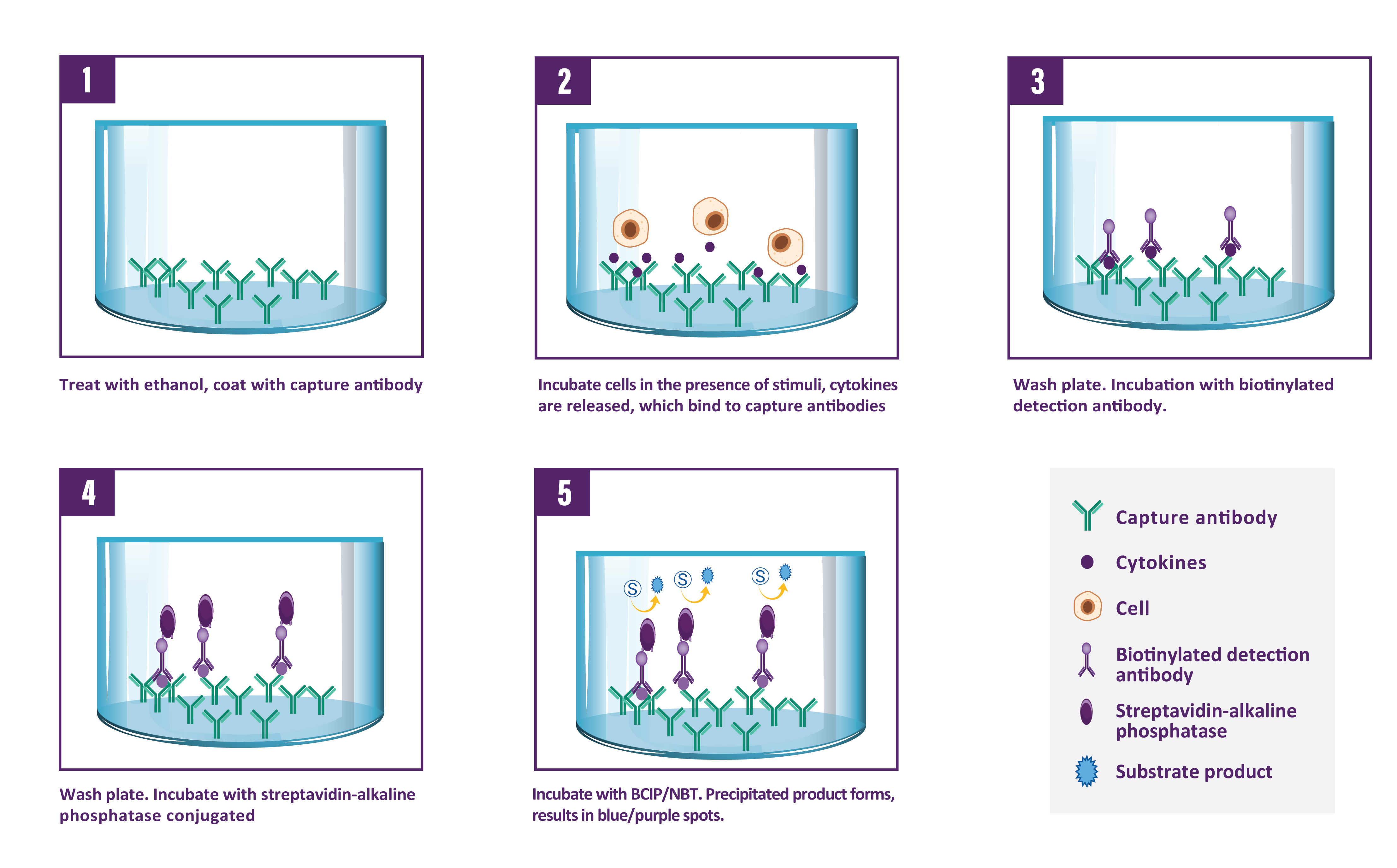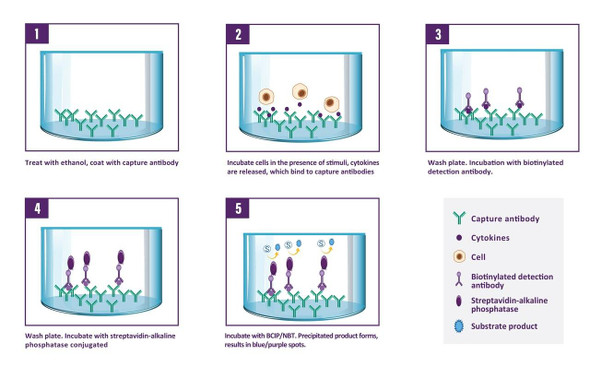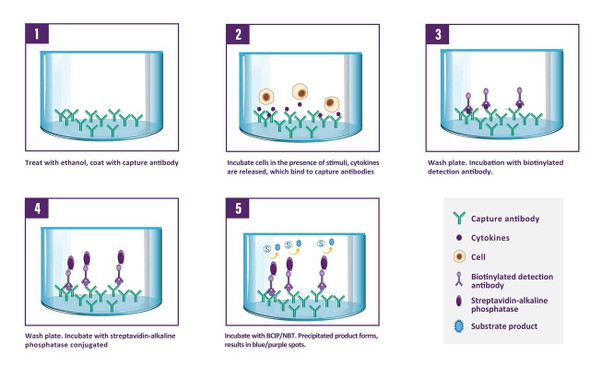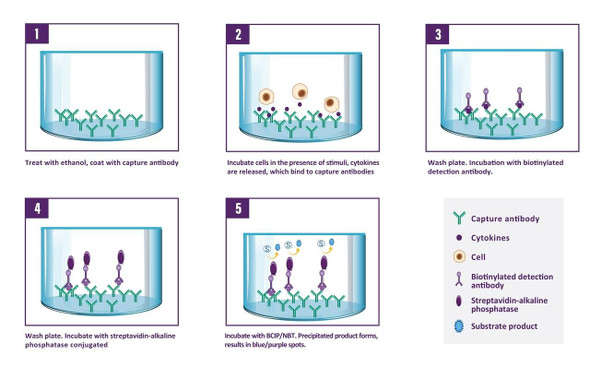Description
Human IL-1 beta ELISpot Kit
Assay Genie ELISpot is a highly specific immunoassay for the analysis of IL-1β production and secretion from T-cells at a single cell level in conditions closely comparable to the in-vivo environment with minimal cell manipulation. This technique is designed to determine the frequency of IL-1β producing cells under a given stimulation and the comparison of such frequency against a specific treatment or pathological state. Utilising sandwich immuno-enzyme technology, Assay Genie ELISpot assays can detect both secreted IL-1β (qualitative analysis) and single cells that produce IL-1β (quantitative analysis). Cell secreted IL-1β is captured by coated antibodies avoiding diffusion in supernatant, protease degradation or binding on soluble membrane receptors. After cell removal, the captured IL-1β is revealed by tracer antibodies and appropriate conjugates.
Human IL-1 beta ELISpot Kit
The Human IL-1 Beta ELISpot Kit is specifically designed for the quantitative detection of Interleukin-1 Beta levels in human samples such as serum, plasma, and cell culture supernatants. This kit offers high sensitivity and specificity, ensuring accurate and reliable results for various research applications.Interleukin-1 Beta is a pro-inflammatory cytokine that plays a crucial role in the regulation of immune responses and inflammatory processes. Elevated levels of IL-1 Beta have been associated with various inflammatory conditions such as rheumatoid arthritis, inflammatory bowel disease, and autoimmune disorders.
Therefore, the accurate measurement of IL-1 Beta levels is essential for understanding the pathogenesis of these conditions and developing targeted therapies.With its high performance and ease of use, the Human IL-1 Beta ELISpot Kit is a valuable tool for researchers studying inflammatory diseases and immune responses. Order now to advance your research with confidence and precision.
| Product type: | ELISpot Kit |
| Size: | 1 x 96 Assays |
| Target species: | Human |
| Specificity: | Recognizes natural human IL-1β |
| Incubation: | 3h after cell stimulation |
| Kit content: | Assay Genie Pre-coated ELISpot kits include precoated PVDF plates, Detection antibody, Alkaline phosphatase conjugate, BSA, BCIP/NBT ready-to-use substrate buffer. |
| Synonyms: | IL-1b, IL-1beta |
| Uniprot: | P01584 |
A capture antibody highly specific for IL-1β is coated to the wells of a PVDF bottomed 96 well microtitre plate either during kit manufacture or in the laboratory. The plate is then blocked to minimise any non-antibody dependent unspecific binding and washed. Cell suspension and stimulant are added and the plate incubated allowing the specific antibodies to bind any IL-1β produced. Cells are then removed by washing prior to the addition of Biotinylated detection antibodies which bind to the previously captured IL-1β. Enzyme conjugated streptavidin is then added binding to the detection antibodies. Following incubation and washing, substrate is then applied to the wells resulting in coloured spots which can be quantified using appropriate analysis software or manually using a microscope.

| Step | Procedure |
| 1. | For PVDF membrane activation, add 25 µl of 35% ethanol to every well. |
| 2. | Incubate plate at room temperature (RT) for 30 seconds. |
| 3. | Empty the wells by flicking the plate over a sink & gently tapping on absorbent paper. Thoroughly wash the plate 3x with 100 µl of PBS 1X per well. |
| 4. | Add 100 µl of diluted capture antibody to every well. |
| 5. | Cover the plate and incubate at 4°C overnight. |
| 6. | Empty the wells as previous and wash the plate once with 100 µl of PBS 1X per well. |
| 7. | Add 100 µl of blocking buffer to every well. |
| 8. | Cover the plate and incubate at RT for 2 hours. |
| 9. | Empty the wells as previous and thoroughly wash once with 100 µl of PBS 1X per well. |
| 10. | Add 100 µl of sample, positive and negative controls cell suspension to appropriate wells providing the required concentration of cells and stimulant. |
| 11. | Cover the plate and incubate at 37°C in a CO2 incubator for an appropriate length of time (15-20 hours). Note: do not agitate or move the plate during this incubation. |
| 12. | Empty the wells and remove excess solution then add 100 µl of Wash Buffer to every well. |
| 13. | Incubate the plate at 4°C for 10 min. |
| 14. | Empty the wells as previous and wash the plate 3x with 100 µl of Wash Buffer. |
| 15. | Add 100 µl of diluted detection antibody to every well. |
| 16. | Cover the plate and incubate at RT for 1 hour 30 min. |
| 17. | Empty the wells as previous and wash the plate 3x with 100 µl of Wash Buffer. |
| 18. | Add 100 µl of diluted Streptavidin-conjugate to every well. |
| 19. | Cover the plate and incubate at RT following the supplier's instructions. |
| 20. | Empty the wells and wash the plate 3x with 100 µl of Wash Buffer. |
| 21. | Peel of the plate bottom and wash both sides of the membrane 3x under running distilled water, once washing complete remove any excess solution by repeated tapping on absorbent paper. |
| 22. | Add 100 µl of ready-to-use substrate buffer to every well. |
| 23. | Following the supplier's instructions, incubate the plate for 5-15 min monitoring spot formation visually throughout the incubation period to assess sufficient colour development. |
| 24. | Empty the wells and rinse both sides of the membrane 3x under running distilled water. Completely remove any excess solution by gentle repeated tapping on absorbent paper Read Spots: allow the wells to dry and then read results. The frequency of the resulting coloured spots. |
| UniProt Protein Function: | IL1B: Produced by activated macrophages, IL-1 stimulates thymocyte proliferation by inducing IL-2 release, B-cell maturation and proliferation, and fibroblast growth factor activity. IL-1 proteins are involved in the inflammatory response, being identified as endogenous pyrogens, and are reported to stimulate the release of prostaglandin and collagenase from synovial cells. Monomer. Belongs to the IL-1 family. |
| UniProt Protein Details: | Protein type:Cytokine Chromosomal Location of Human Ortholog: 2q14 Cellular Component: extracellular space; extracellular region; cytosol; secretory granule Molecular Function:protein domain specific binding; interleukin-1 receptor binding; cytokine activity Biological Process: positive regulation of granulocyte macrophage colony-stimulating factor production; negative regulation of MAP kinase activity; positive regulation of nitric oxide biosynthetic process; activation of MAPK activity; positive regulation of transcription, DNA-dependent; positive regulation of interleukin-2 biosynthetic process; germ cell programmed cell death; negative regulation of insulin receptor signaling pathway; positive regulation of lipid catabolic process; positive regulation of NF-kappaB import into nucleus; fever; positive regulation of membrane protein ectodomain proteolysis; response to carbohydrate stimulus; activation of NF-kappaB transcription factor; cell-cell signaling; positive regulation of phagocytosis; positive regulation of T cell mediated immunity; positive regulation of T cell proliferation; neutrophil chemotaxis; positive regulation of I-kappaB kinase/NF-kappaB cascade; positive regulation of heterotypic cell-cell adhesion; positive regulation of mitosis; smooth muscle adaptation; interleukin-1 beta production; positive regulation of interleukin-6 production; positive regulation of angiogenesis; positive regulation of transcription from RNA polymerase II promoter; positive regulation of transcription factor activity; negative regulation of lipid metabolic process; sequestering of triacylglycerol; positive regulation of histone phosphorylation; apoptosis; positive regulation of interleukin-6 biosynthetic process; positive regulation of JNK cascade; signal transduction; positive regulation of vascular endothelial growth factor receptor signaling pathway; positive regulation of protein export from nucleus; positive regulation of interleukin-8 production; negative regulation of cell proliferation; negative regulation of lipid catabolic process; hyaluronan biosynthetic process; protein kinase B signaling cascade; lipopolysaccharide-mediated signaling pathway; inflammatory response; regulation of I-kappaB kinase/NF-kappaB cascade; cytokine and chemokine mediated signaling pathway; MAPKKK cascade; response to ATP; positive regulation of interferon-gamma production; positive regulation of chemokine biosynthetic process; positive regulation of prostaglandin secretion; positive regulation of fever; positive regulation of histone acetylation; immune response; positive regulation of protein amino acid phosphorylation; regulation of insulin secretion; embryo implantation Disease: Gastric Cancer, Hereditary Diffuse |
| NCBI Summary: | The protein encoded by this gene is a member of the interleukin 1 cytokine family. This cytokine is produced by activated macrophages as a proprotein, which is proteolytically processed to its active form by caspase 1 (CASP1/ICE). This cytokine is an important mediator of the inflammatory response, and is involved in a variety of cellular activities, including cell proliferation, differentiation, and apoptosis. The induction of cyclooxygenase-2 (PTGS2/COX2) by this cytokine in the central nervous system (CNS) is found to contribute to inflammatory pain hypersensitivity. This gene and eight other interleukin 1 family genes form a cytokine gene cluster on chromosome 2. [provided by RefSeq, Jul 2008] |
| UniProt Code: | P01584 |
| NCBI GenInfo Identifier: | 62906858 |
| NCBI Gene ID: | 3553 |
| NCBI Accession: | P01584.2 |
| UniProt Secondary Accession: | P01584,Q53X59, Q53XX2, Q7M4S7, Q7RU01, Q96HE5, Q9UCT6 |
| UniProt Related Accession: | P01584 |
| Molecular Weight: | 30,748 Da |
| NCBI Full Name: | Interleukin-1 beta |
| NCBI Synonym Full Names: | interleukin 1, beta |
| NCBI Official Symbol: | IL1B‚ ‚ |
| NCBI Official Synonym Symbols: | IL-1; IL1F2; IL1-BETA‚ ‚ |
| NCBI Protein Information: | interleukin-1 beta; IL-1 beta; catabolin; preinterleukin 1 beta; pro-interleukin-1-beta |
| UniProt Protein Name: | Interleukin-1 beta |
| UniProt Synonym Protein Names: | Catabolin |
| Protein Family: | Interleukin |
| UniProt Gene Name: | IL1B‚ ‚ |
| UniProt Entry Name: | IL1B_HUMAN |










